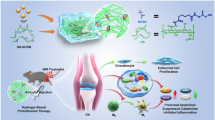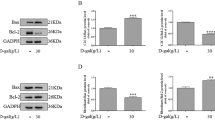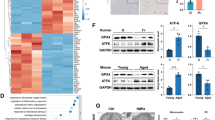Abstract
Intra-articular injection of glucocorticoids (GCs) has been widely used in the management of osteoarthritis and rheumatoid arthritis. Nevertheless, several studies showed that GCs had toxic effects on chondrocytes as well as synovial cells. Previously we reported the protective role of autophagy in the degeneration of meniscal tissues. However, the effects of GCs on autophagy in the meniscal cells have not been fully elucidated. To investigate whether GCs can regulate autophagy in human meniscal cells, the meniscal cells were cultured in vitro and exposed in the presence of dexamethasone. The levels of apoptosis and autophagy were investigated via flow cytometry as well as western blotting analysis. The changes of the aggrecanases were measured using real-time PCR. The role of autophagy in dexamethasone-induced apoptosis was investigated using pharmacological agents and RNA interference technique. An agonist of inositol 1,4,5-trisphosphate receptor (IP3R) was used to investigate the mechanism of dexamethasone-induced autophagy. The results showed that dexamethasone induced autophagy as well as apoptosis in normal human meniscal cells. Using RNA interference technique and pharmacological agents, our results showed that autophagy protected the meniscal cells from dexamethasone-induced apoptosis. Our results also indicated that dexamethasone increased the mRNA levels of aggrecanases. This catabolic effect of dexamethasone was enhanced by 3-MA, the autophagy inhibitor. Furthermore, our results showed that dexamethasone induced autophagy via suppressing the phosphorylation of IP3R. In summary, our results indicated that autophagy protected meniscal cells from GCs-induced apoptosis via inositol trisphosphate receptor signaling.





Similar content being viewed by others
References
Salata MJ, Gibbs AE, Sekiya JK (2010) A systematic review of clinical outcomes in patients undergoing meniscectomy. Am J Sports Med 38:1907–1916
Englund M, Roemer FW, Hayashi D, Crema MD, Guermazi A (2012) Meniscus pathology, osteoarthritis and the treatment controversy. Nat Rev Rheumatol 8:412–419
MacMullan PA, McCarthy GM (2010) The meniscus, calcification and osteoarthritis: a pathologic team. Arthritis Res Ther 12:116
Cyriax J, Troisier O (1953) Hydrocortone and soft-tissue lesions. Br Med J 2:966–968
Murrell GA, Doland MM, Jang D, Szabo C, Warren RF, Hannafin JA (1996) Nitric oxide: an important articular free radical. J Bone Joint Surg Am 78:265–274
Dragoo JL, Danial CM, Braun HJ, Pouliot MA, Kim HJ (2012) The chondrotoxicity of single-dose corticosteroids. Knee Surg Sports Traumatol Arthrosc 20:1809–1814
Braun HJ, Wilcox-Fogel N, Kim HJ, Pouliot MA, Harris AH, Dragoo JL (2012) The effect of local anesthetic and corticosteroid combinations on chondrocyte viability. Knee Surgery Sports Traumatol Arthrosc 20:1689–1695
Mistiaen WP, Somers P, Knaapen MW, Kockx MM (2006) Autophagy as mechanism for cell death in degenerative aortic valve disease. Autophagy 2:221–223
Bredesen DE, Rao RV, Mehlen P (2006) Cell death in the nervous system. Nature 443:796–802
Mizushima N, Komatsu M (2011) Autophagy: renovation of cells and tissues. Cell 147:728–741
Shen C, Yan J, Jiang LS, Dai LY (2011) Autophagy in rat annulus fibrosus cells: evidence and possible implications. Arthritis Res Ther 13:R132
Carames B, Hasegawa A, Taniguchi N, Miyaki S, Blanco FJ, Lotz M (2012) Autophagy activation by rapamycin reduces severity of experimental osteoarthritis. Ann Rheum Dis 71:575–581
Carames B, Taniguchi N, Otsuki S, Blanco FJ, Lotz M (2010) Autophagy is a protective mechanism in normal cartilage, and its aging-related loss is linked with cell death and osteoarthritis. Arthritis Rheum 62:791–801
Shen C, Yan J, Erkocak OF, Zheng XF, Chen XD (2014) Nitric oxide inhibits autophagy via suppression of JNK in meniscal cells. Rheumatology 53:1022–1033
Yu L, Wan F, Dutta S et al (2006) Autophagic programmed cell death by selective catalase degradation. Proc Natl Acad Sci USA 103:4952–4957
White C, Li C, Yang J et al (2005) The endoplasmic reticulum gateway to apoptosis by Bcl-X(L) modulation of the InsP3R. Nat Cell Biol 7:1021–1028
Szlufcik K, Bultynck G, Callewaert G, Missiaen L, Parys JB, De Smedt H (2006) The suppressor domain of inositol 1,4,5-trisphosphate receptor plays an essential role in the protection against apoptosis. Cell Calcium 39:325–336
Camandola S, Cutler RG, Gary DS, Milhavet O, Mattson MP (2005) Suppression of calcium release from inositol 1,4,5-trisphosphate-sensitive stores mediates the anti-apoptotic function of nuclear factor-kappaB. J Biol Chem 280:22287–22296
Song YW, Zhang T, Wang WB (2012) Gluococorticoid could influence extracellular matrix synthesis through Sox9 via p38 MAPK pathway. Rheumatol Int 32:3669–3673
Decuypere J-P, Welkenhuyzen K, Luyten T et al (2011) IP3 receptor-mediated Ca2+ signaling and autophagy induction are interrelated. Autophagy 7:1472–1489
Harr MW, McColl KS, Zhong F, Molitoris JK, Distelhorst CW (2010) Glucocorticoids downregulate Fyn and inhibit IP(3)-mediated calcium signaling to promote autophagy in T lymphocytes. Autophagy 6:912–921
Vicencio JM, Ortiz C, Criollo A et al (2009) The inositol 1,4,5-trisphosphate receptor regulates autophagy through its interaction with Beclin 1. Cell Death Differ 16:1006–1017
Criollo A, Maiuri MC, Tasdemir E et al (2007) Regulation of autophagy by the inositol trisphosphate receptor. Cell Death Differ 14:1029–1039
Biederbick A, Kern HF, Elsasser HP (1995) Monodansylcadaverine (MDC) is a specific in vivo marker for autophagic vacuoles. Eur J Cell Biol 66:3–14
Smolen JS, Landewe R, Breedveld FC et al (2014) EULAR recommendations for the management of rheumatoid arthritis with synthetic and biological disease-modifying antirheumatic drugs: 2013 update. Ann Rheum Dis 73:492–509
Hirsch G, Kitas G, Klocke R (2013) Intra-articular corticosteroid injection in osteoarthritis of the knee and hip: factors predicting pain relief–a systematic review. Semin Arthritis Rheum 42:451–473
Ishikawa K (1981) Effect of intra-articular corticosteroid on the meniscus. A histological and histochemical study in rabbit knees. J Bone Joint Surg Am 63:120–130
Chrysis D, Ritzen EM, Savendahl L (2003) Growth retardation induced by dexamethasone is associated with increased apoptosis of the growth plate chondrocytes. J Endocrinol 176:331–337
Annefeld M (1992) Changes in rat epiphyseal cartilage after treatment with dexamethasone and glycosaminoglycan-peptide complex. Pathol Res Pract 188:649–652
Evans JF, Shen CL, Pollack S, Aloia JF, Yeh JK (2005) Adrenocorticotropin evokes transient elevations in intracellular free calcium ([Ca2+]i) and increases basal [Ca2+]i in resting chondrocytes through a phospholipase C-dependent mechanism. Endocrinology 146:3123–3132
Yao W, Dai W, Jiang JX, Lane NE (2013) Glucocorticoids and osteocyte autophagy. Bone 54:279–284
Ivanova H, Vervliet T, Missiaen L, Parys JB, De Smedt H, Bultynck G (2014) Inositol 1,4,5-trisphosphate receptor-isoform diversity in cell death and survival. Biochimica et Biophysica Acta 1843(10):2164–2183
Luciani DS, Gwiazda KS, Yang TL et al (2009) Roles of IP3R and RyR Ca2+ channels in endoplasmic reticulum stress and beta-cell death. Diabetes 58:422–432
Steinmann C, Landsverk ML, Barral JM, Boehning D (2008) Requirement of inositol 1,4,5-trisphosphate receptors for tumor-mediated lymphocyte apoptosis. J Biol Chem 283:13506–13509
Criollo A, Vicencio JM, Tasdemir E, Maiuri MC, Lavandero S, Kroemer G (2007) The inositol trisphosphate receptor in the control of autophagy. Autophagy 3:350–353
Harr MW, Rong Y, Bootman MD, Roderick HL, Distelhorst CW (2009) Glucocorticoid-mediated inhibition of Lck modulates the pattern of T cell receptor-induced calcium signals by down-regulating inositol 1,4,5-trisphosphate receptors. J Biol Chem 284:31860–31871
Davis MC, McColl KS, Zhong F, Wang Z, Malone MH, Distelhorst CW (2008) Dexamethasone-induced inositol 1,4,5-trisphosphate receptor elevation in murine lymphoma cells is not required for dexamethasone-mediated calcium elevation and apoptosis. J Biol Chem 283:10357–10365
Acknowledgments
This study was supported by the National Natural Science Foundation of China (81101379, 81472118,81171705) and the Natural Science Fund of the Shanghai Jiao Tong University School of Medicine (11XJ21022).
Conflict of interest
The authors have declared no conflicts of interest.
Author information
Authors and Affiliations
Corresponding author
Additional information
Chao Shen and Wen Gu have contributed equally to this study.
Rights and permissions
About this article
Cite this article
Shen, C., Gu, W., Cai, GQ. et al. Autophagy protects meniscal cells from glucocorticoids-induced apoptosis via inositol trisphosphate receptor signaling. Apoptosis 20, 1176–1186 (2015). https://doi.org/10.1007/s10495-015-1146-9
Published:
Issue Date:
DOI: https://doi.org/10.1007/s10495-015-1146-9




